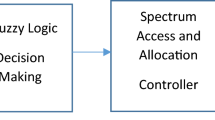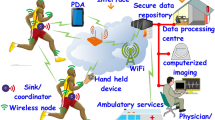Abstract
The cloud radio access network (C-RAN) promises significant gain to the data rate over the LTE-advanced by transferring the burdensome baseband signal processing from the remote radio heads (RRHs) to the baseband unit via the front-haul. However, scalable improvement of the overall throughput may not be maintained due to limited front-haul capacity. In this paper, we study the throughput maximization problem by selecting the active RRHs. In particular, we develop an optimum algorithm which selects a subset of active RRHs that maximize the system throughput under the front-haul constraint. In addition, the asymptotically optimum number of RRHs is derived in closed-form for low and high signal-to-noise ratio (SNR) regimes. It is demonstrated that the proposed RRH selection scheme outperforms any other existing schemes with substantial gain of achievable throughput for any given number of RRHs and any predetermined front-haul capacity constraints.
创新点
云无线接入网络把艰巨的基带信号处理任务从远程射频单元转移到基带信号处理单元,这二者之间通过光纤连接,今儿能够获得比现代长期演进系统(LTE-advanced)更为高速的数据速率。 然而,远程射频单元与基带信号处理单元之间的连接称为前向回城链路,该链路容量严重制约该吞吐量的明显提升。本论文通过设计远程射频单元的最优选择方案,进而降低前向回程容量的数据速率开销,最终提高整个系统的吞吐量。 特别地,我们提出了一个最优算法,该算法从所有可用的远程射频单元集合中选择一个子集,该子集能够在前向回程容量约束前提下最大化系统的吞吐量。另外,我们理论分析出远程射频单元的最优数目分别在高信噪比和低信噪比场景下的解析表达式, 计算机数值仿真表明所提远程射频单元最优选择算法明显超越了现有方案,所实现的增益在任意给定的前向回程容量约束和任何给定的所有远程射频单元集合情况下都是非常明显的。
Similar content being viewed by others
References
Li N, Fei Z, Xing C, et al. Robust low-complexity MMSE precoding algorithm for cloud radio access networks. IEEE Commun Lett, 2014, 18: 773–776
Peng M, Yang S, Poor H V. Ergodic capacity analysis of remote radio head associations in cloud radio access networks. IEEE Wirel Commun Lett, 2014, 3: 365–368
Shi Y, Zhang J, Letaief K B, et al. Large-scale convex optimization for ultra-dense cloud-RAN. IEEE Wirel Commun, 2015, 22: 84–91
Zhou S, Zhao T, Niu Z, et al. Software-defined hyper-cellular architecture for green and elastic wireless access. IEEE Commun Mag, 2016, 54: 12–19
Liu J, Zhao T, Zhou S, et al. CONCERT: a cloud-based arcitecture for next generation cellular systems. IEEE Wirel Commun, 2014, 21: 14–22
Dai B B, YuW. Sparse beamforming and user-centric clustering for downlink cloud radio access network. IEEE Access, 2014, 2: 1326–1339
Zhang X, Zhang Y, Yu R, et al. Enhancing spectral-energy efficiency for LTE-advanced heterogeneous networks: a users social pattern perspective. IEEE Wirel Commun, 2012, 21: 10–17
Zhang X, Yu R, Zhang Y, et al. Energy-efficient multimedia transmissions through base station cooperation over heterogeneous cellular networks exploiting user behavior. IEEE Wirel Commun, 2014, 21: 54–61
Xing C, Ma S, Zhou Y. Matrix-monotonic optimization for MIMO systems. IEEE Trans Signal Process, 2015, 63: 334–348
Dai M, Kwan H Y, Sung C W. Linear network coding strategies for the multiple-access relay channel with packet erasures. IEEE Trans Wirel Commun, 2013, 12: 218–227
Suryaprakash V, Rost P, Fettweis G. Are heterogeneous cloud-based radio access networks cost effictive? IEEE J Sel Areas Commun, 2015, 33: 2239–2240
Peng M, Xie X, Hu Q, et al. Contract-based interference coordination in heterogeneous cloud radio access networks. IEEE J Sel Areas Commun, 2015, 33: 1140–1153
Vu T X, Nguyen H D, Quek T Q S. Adaptive compression and joint detection for fronthaul uplinks in cloud radio access networks. IEEE Trans Commun, 2015, 63: 4565–4575
Xie X, Peng M, Wang W, et al. Training design and channel estimation in uplink cloud radio access networks. IEEE Signal Process Lett, 2015, 22: 1060–1064
Liu L, Zhang R. Optimized uplink transmission in multi-antenna C-RAN with spatial compression and forward. IEEE Trans Signal Process, 2015, 63: 5083–5095
Li N, Fei Z, Xing C, et al. Robust low-complexity MMSE precoding algorithm for cloud radio access networks. IEEE Commun Lett, 2014, 18: 773–776
Li J, Peng M, Cheng A, et al. Resource allocation optiization for delay-sensitive traffic in fronthaul constrained cloud radio-access networks. IEEE Syst J, 2014, 99: 1–12
Liu L, Bi S, Zhang R. Joint power control and fronthaul rate allocation for throughput maximization in OFDMA-based cloud radio access network. IEEE Trans Commun, 2015, 63: 4097–4110
Garcia V, Zhou Y, Shi J. Coordinated multipoint transmission in dense cellular networks with user-centric adaptive clustering. IEEE Trans Wirel Commun, 2014, 13: 4297–4308
Kim T M, Sun F, Paulraj A J. Low-complexity MMSE precoding for coordinated multipoint with per-antenna power constraint. IEEE Signal Process Lett, 2013, 20: 395–398
Wang D M, Zhang Y, Wei H, et al. An overview of transmission theory and techniques of large-scaleantenna systems for 5G wireless communications. Sci China Inf Sci, 2016, 46: 081301
Rao X, Lau V K N. Distributed fronthaul compression and joint signal recovery in cloud-RAN. IEEE Trans Signal Process, 2015, 63: 1056–1065
Zhou Y, Yu W. Optimized backhaul compression for uplink cloud radio access network. IEEE J Sel Areas Commun, 2014, 32: 1295–1307
Chen W, Wassell I J. Optimized node selection for compressive sleeping wireless sensor networks. IEEE Trans Veh Tech, 2016, 65: 827–836
Wu J, Bao Y, Miao G, et al. Base-station sleeping control and power matching for energy-delay tradeoffs with bursty traffic. IEEE Transx Veh Tech, 2016, 65: 3657–3675
Author information
Authors and Affiliations
Corresponding author
Rights and permissions
About this article
Cite this article
Li, C., Song, K., Wang, D. et al. Optimal remote radio head selection for cloud radio access networks. Sci. China Inf. Sci. 59, 102315 (2016). https://doi.org/10.1007/s11432-016-0060-y
Received:
Accepted:
Published:
DOI: https://doi.org/10.1007/s11432-016-0060-y




